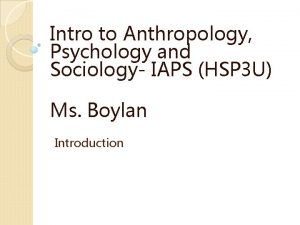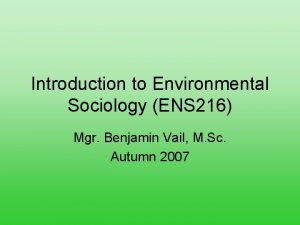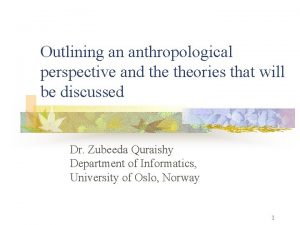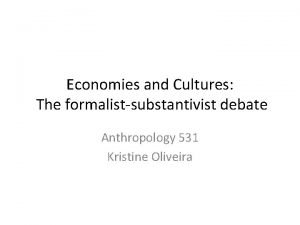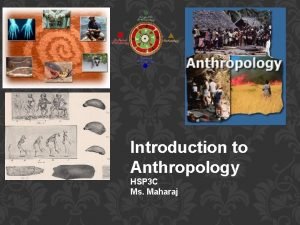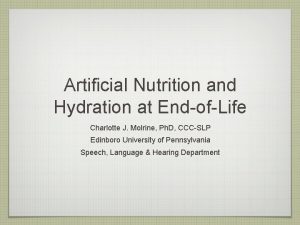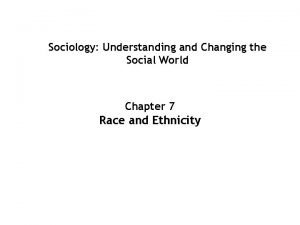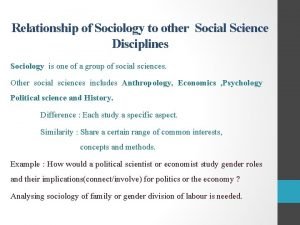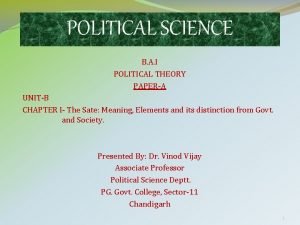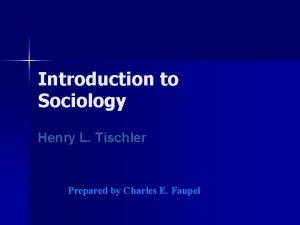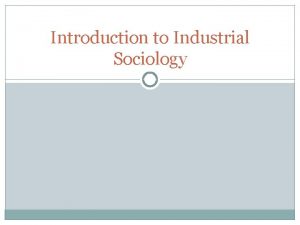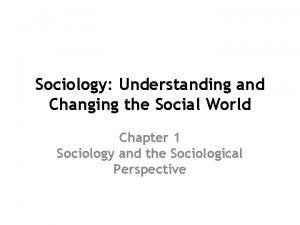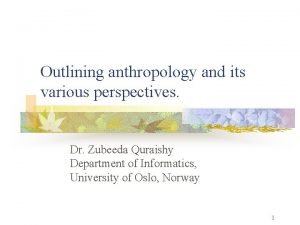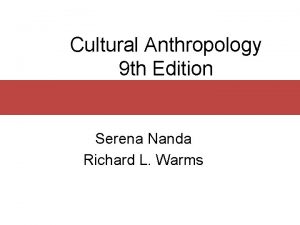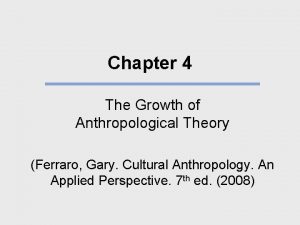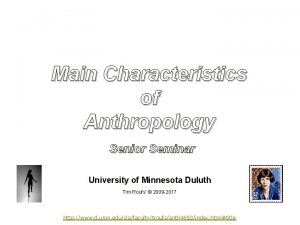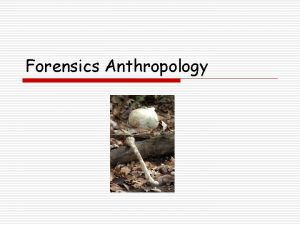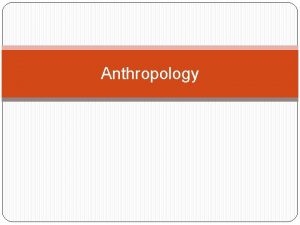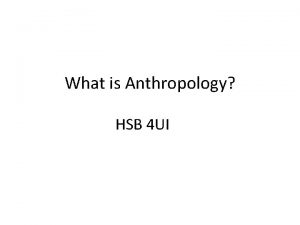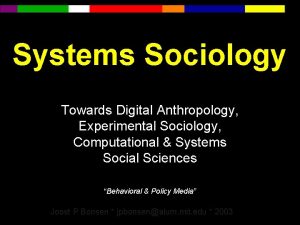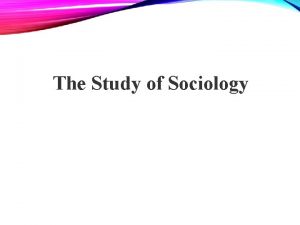ANTHROPOLOGY AND SOCIOLOGY OF NUTRITION Lecture 6 Anthropology




























































- Slides: 60

ANTHROPOLOGY AND SOCIOLOGY OF NUTRITION

Lecture 6 Anthropology of Nutrition Difference between anthropology and sociology

Anthropology (Merriam Webster Dictionary) the science of human beings especially : the study of human beings and their ancestors through time and space and in relation to physical character, environmental and social relations, and culture

Sociology (Merriam Webster Dictionary) • 1: the science of society , social institutions, and social relationships specifically : the systematic study of the development, structure, interaction, and collective behavior of organized groups of human beings • 2 : the scientific analysis of a social institution as a functioning whole and as it relates to the rest of society

India-Anthropology of Nutrition? In late 1960 s there was a famine in India well fed cattle intermingled and competed with people for food -it appeared people would rather starve than eat cattle -concept of spiritual values being more important than life itself

-some have suggested that this is irrational -irrational in that people are overlooking nutritious foods for scarcer less healthy foods -what are the advantages of such spirituality?

-there is a carry over into politics -demonstrations for the protection of the cow -in Nepal ( a Hindu state) an American driver accidently hit a cow and was charged with murder- to avoid an international incident the Nepalese magistrate decided that the cow had committed suicide by wandering in front of the car

-prevailing view among many Indians today however is that the large animal population is more a liability than an asset in view of land resources -remember there is a large human population requiring land for food production -efficiency of crop yields-tractor versus cow

the easy explanation for India’s devotion to the cow is that it is an integral part of Hinduism -the concept that religion is good for the soul even if it sometimes fails the body -religion orders the cosmos and explains our place in the universe -many would claim that religious beliefs have existed for thousands of years and have a life of their own-they are not understandable in scientific terms

However, all this ignores history -2000 Before Common Era (BCE) -cows were slaughtered and eaten for Hindu sacrificial rite -1000 BCE- contradictory passages in Vedas (Hindu sacred texts) some referring to ritual slaughter; others to prohibition of beef eating

-200 Common Era (CE)-priests exhorted population to venerate the cow and beef eating was permitted only by nobility -1000 CE-all beef eating prohibited in part because of desire of Hindus to set themselves apart from 8 th century Islamic invaders who did eat beef

In reality the prohibition of beef eating occurred to prevent people eating animals essential to Indian agriculture Before 300 BCE Ganges valley was heavily forested -as population increased and by 300 BCE between 50 and 100 million people were living in India- valley underwent signs of ecological collapse

-droughts and floods became commonplace – erosion washed away rich topsoil -farms shrank as population increased and domesticated animals became harder and harder to maintain -as the population increased the only way of keeping pace with increased demand for food was to save cows to produce oxen to plough the fields

-those who ate beef lost the tools to farm -only later was the practice written into religious law by priests to protect cows from a population that was starving

advantages of not eating meat: -cows able to produce oxen -oxen plough the fields -dung used as fuel for cooking and fertilising -energy in a vegetarian diet goes much further than meat-why?

contrast these advantages to: –in the US -91 % of cereal, legume and vegetable protein suitable for human consumption is fed to cattle to produce meat for human consumption -in the production of milk and meat US farmers use fossil fuels to the equivalent 82 million barrels of oil annually -emissions of greenhouse gases- impact of this on world food production?

However, there is a move on in western societies to produce energy from cow dung bacteria breakdown cow dung producing methane gas and carbon dioxide is removed

What are the nutritional implications of the two approaches: -type II diabetes -atherosclerosis -obesity -blood pressure -adequacy -balance -energy control -nutrient density -variety -moderation

Whether practices and beliefs are rational or irrational it is true that failure to adapt to the environment dooms us to extinction Remember we don’t eat dogs and place great value on the car and polluting industries

Time for us to adopt the system in India?

THE WEST - SOCIOLOGY OF NUTRITION?

Nutritional Trends -development of nutritional science and cognate disciplines -developments in research on food consumption -trends in nutritional policies

Development of nutritional science and cognate disciplines -started in 1850 in Europe in France, Germany and Netherlands -since gained importance due to concept of welfare state

-origins and growth of nutritional science were stimulated by: -the practical problems of food and health, -food storage and long distance food transport, -19 th century conditions of scarcity and ill health among the working classes of industrialising western European countries were also of political and public health significance and also contributed to the growth of nutritional science

-origins and growth of nutritional science were stimulated by: -doctors visiting the poor in western European slums came to blame the inadequate food supply for widespread infant mortality, feebleness, ill health and susceptibility to epidemic diseases -growth of the food industry- rules against food adulteration -poor food quality

-today nutritionists in western countries are stressing the importance of the relationship between good food and health -heart disease -type 2 diabetes -gestational diabetes -obesity -blood pressure -stroke -arthritis and weight -cancer

-advisory committees to federal and provincial governments have M. Ds. and Ph. Ds to advise on policies meant to overcome these problems -nutritional science draws on biology (including molecular), biochemistry, microbiology and physiology -also draws on history, psychology, sociology, anthropology, political and economic science

Research on food consumption and eating habits Large scale epidemiological studies -food intake, nutritional status, health characteristics and social variables

Research on food consumption and eating habits Small scale-epidemological studies -subgroups -with or without biomedical and nutritional data -particular emphasis on pregnancy, birth and infancy, youth and old age -other subgroups-the sick, the poor, students, immigrants, adherents of strict food intakes (eg some extremes of vegetarianism)

Research on food consumption and eating habits Small scale-epidemological studies -school feeding programmes and food security -social inequality in food and hence in our health -often such studies are undertaken in periods of declining welfare or economic depression and other times of hazard for groups of the population with weak income positions

Research on food consumption and eating habits Small scale-epidemological studies -social inequality in food and hence in our health -hunger is still a problem in Canada

Research on food consumption and eating habits Small scale-epidemological studies -social inequality in food and hence in our health -the elderly-they are a growing population -aim of nutrient intake studies with elderly is to ensure their health in the face of growing age related health issues- this will help them live in their own homes- cheaper for government than hospital

Trends in Nutritional Policies Development of national food policies- -government initiated -prevent illness

Trends in Nutritional Policies Development of national food policies- government initiated: -further public health by informing people about the importance of a prudent diet -people advised to eat more fruits and vegetables and fibre containing foodstuffs and to watch out for excessive fats (trans and saturated fats in particular)

Trends in Nutritional Policies Development of national food policies- government initiated: Further public health by informing them about importance of a prudent diet -food policy promoting food safety -this means issuing and enforcing regulations for: -food producing -food processing -food distributing companies

Trends in Nutritional Policies Development of national food policies- government initiated: Further public health by informing them about importance of a prudent diet -complex organisations and networks set up -purposes of: -public enlightenment -public education -research -control

Trends in Nutritional Policies Development of national food policies- government initiated: Further public health by informing them about importance of a prudent diet -Norwegian Nutrition and Food Policy -promote healthier eating habits -stabilise world food supply -increase national self-sufficiency -strengthen the rural economy Canada has a similar approach to the Norwegians

Trends in Nutritional Policies Development of national food policies- government initiated: Further public health by informing them about importance of a prudent diet -one food policy does not fit everyone in the population -individual’s response to diet or a change in diet is highly individual

Trends in Nutritional Policies Development of national food policies- government initiated: Further public health by informing them about importance of a prudent diet -some policies do not recognise that : -one food policy does not fit everyone in population -individuals response to diet and diet change affected by genome and environmental influences outside the realm of diet

Trends in Nutritional Policies Development of national food policies- government initiated: -failure to sustain agriculture due to policies that are not ecologically sound (e. g. irrigation) -hunger is frequently due to inadequate food distribution rather than food production

Trends in Nutritional Policies Development of national food policies- government initiated: -some policies do not recognise : -sociocultural habits of people whose food habits such policies are intended to change

Food technology and its impact Industrialisation of Agricultural and Artisan Food Production Distribution Preparation and Consumption Recent Developments in Food Technology The rise of agribusiness and other global food networks Additives, contaminants and convenience food Proliferation of bioindustry Implications for Contemporary Consumers and Consumption

Food technology has had a tremendous impact on western societies -impact on the production, distribution, preparation and consumption of food -these are the main phases of the social role of food in our society -remember that science and business are very much institutions in our society and therefore can fall into realm of sociology

Industrialisation of Agricultural and Artisan Food Production From 1800 onwards chemistry, biology, microbiology and physiology played and continue to play a role in the development of nutrition science These areas allowed an understanding of the exact composition of food and about the microprocesses which lead to microbial growth and decay Mechanisation encountered the organic- tractors, artificial fertilisers and pesticides structurally changed agriculture ensuring larger harvests

Industrialisation of Agricultural and Artisan Food Production The above developments and the development of sterilisation permitted the development of large food corporations Thus the farm and artisan production of grain and then flour and bread, the preservation of meat and vegetables and the making of bread and cheese were quickly replaced by baking, canning (later freezing) and the milk and dairying industries

Industrialisation of Agricultural and Artisan Food Production -early margarine known as oleo was rumoured by dairy farmers to cause cancer -why would they spread such a rumour?

Distribution -changes in production and processing implied: -a restructuring and massive increase in the size of the markets -this improved transport

Distribution -changes in production and processing implied: -food technology developments resulted in laws against adulteration -changes in retailing- things sold in pre-weighed amounts in packages-different from the open market

Preparation and Consumption -restructuring of life imbedded in the more general social processes of industrialisation has had far reaching consequences for meals and meal patterns -the time, the number, the composition and temperature of the meals changed from artisan and agricultural communities to industrial and urban societies

Preparation and Consumption -these changes reduced food scarcity and hunger and by the 1950 s in Canada hunger for poorer societal members was largely ended and so were the consequences for health? Why not completely ended? -substitutes like margarine and beet sugar became available significance of this?

Preparation and Consumption -other substitutes were potato and corn flour, evaporated milk, biscuits, corn flakes and other cereals, tinned meat, fish and fruits and vegetables -how if at all were these items better for the health of the population? -impact on food preparers in the home?

Preparation and Consumption -development of the electric and gas stoves (later with thermostatic controls), piped water all improved meals -urbanisation and the geographical separation of home from the workplace meant that people had to change consumption patterns -more fast foods

Recent Developments in Food Technology -product innovation has been the key -innovation in terms of new combination of ingredients both synthetic and natural -biotechnology has generated new ingredients - should these be considered synthetic or natural?

Recent Developments in Food Technology The rise of agribusiness and other global food networks -internationalisation in this regard came about because of the need for raw materials -industrial food processes and world markets dictate ingredients-how?

Recent Developments in Food Technology The rise of agribusiness and other global food networks -thus agriculture has become dependent on industry -thus large agrifood businesses have taken over agriculture -advantage of this-discuss -this take-over has lead to merger of food and chemical industries

Recent Developments in Food Technology Additives, contaminants and convenience food -the merger of food and chemical industries has resulted in additives and contaminants in our foods - the result being artificial flavours and the development of fast or convenience foods -such a merger also allowed fast food restaurants and supermarkets which are supported by internal distribution networks

Recent Developments in Food Technology Proliferation of bioindustry -stock breeding -fractioning of food ingredients such as flour and milk into their individual ingredients such as carbohydrates, fats and proteins -significance of this? -ultimately it may be possible to replace agriculture with industry

Implications for Contemporary Consumers and Consumption -fewer meals being consumed together -obesity -taste- convenience foods generally do not taste as good as home- prepared foods -artificial flavours are believed by some to alter taste and smell abilities of humans consuming them

Implications for Contemporary Consumers and Consumption -high energy consumption and waste (eg packaging) -one never knows what one is truly eating- proof-upswing in vegetarianism, natural foods -food scares-salmonella in eggs

What are the sociological implications of these changes? i. e. in terms of human interactions?
 Anthropology psychology and sociology
Anthropology psychology and sociology Anthropology psychology and sociology
Anthropology psychology and sociology What is anthropology
What is anthropology Rapid change
Rapid change Outline of sociology
Outline of sociology Environmental sociology lecture notes
Environmental sociology lecture notes 01:640:244 lecture notes - lecture 15: plat, idah, farad
01:640:244 lecture notes - lecture 15: plat, idah, farad Lumpers and splitters anthropology
Lumpers and splitters anthropology Example of anthropology perspective
Example of anthropology perspective Formalist and substantivist debate
Formalist and substantivist debate Hsp 3c
Hsp 3c Anthropology and its branches
Anthropology and its branches Pros and cons of artificial nutrition and hydration
Pros and cons of artificial nutrition and hydration Leisure
Leisure Common sense sociology
Common sense sociology High commitment management model
High commitment management model Sociology understanding and changing the social world
Sociology understanding and changing the social world Sociology: then and now
Sociology: then and now Sociology then and now
Sociology then and now Formal and informal group in sociology
Formal and informal group in sociology Sociology of disability
Sociology of disability Crime and deviance sociology revision
Crime and deviance sociology revision Functionalism in freaks and geeks
Functionalism in freaks and geeks Economics and sociology relationship
Economics and sociology relationship Relation between sociology and political science
Relation between sociology and political science Political science and ethics
Political science and ethics Disability and psychology
Disability and psychology Chapter 8 deviance and social control
Chapter 8 deviance and social control Formal and informal group in sociology
Formal and informal group in sociology Examples of task groups
Examples of task groups Devva kasnitz
Devva kasnitz Values definition sociology
Values definition sociology Difference between sociology and political science
Difference between sociology and political science Tischler sociology
Tischler sociology Cultural diversity vocabulary
Cultural diversity vocabulary Advantages and disadvantages of observation method
Advantages and disadvantages of observation method Industrial sociology
Industrial sociology Cultural diversity and conformity section 1
Cultural diversity and conformity section 1 Similarities between sociology and social work
Similarities between sociology and social work Nature and scope of sociology
Nature and scope of sociology Sociology: understanding and changing the social world
Sociology: understanding and changing the social world What is anthropology
What is anthropology Thick description anthropology
Thick description anthropology Anthropology perspective example
Anthropology perspective example Body language
Body language Phonemes anthropology
Phonemes anthropology Father of anthropology
Father of anthropology Entomology is the study of _______.
Entomology is the study of _______. Physical anthropology subfields
Physical anthropology subfields Krystiana krupa
Krystiana krupa Anthropology example
Anthropology example Thick description anthropology
Thick description anthropology Psychological anthropology
Psychological anthropology Types of anthropology
Types of anthropology Nonhoning canine
Nonhoning canine University of toronto anthropology masters
University of toronto anthropology masters Configurationalism anthropology
Configurationalism anthropology Verandah anthropology
Verandah anthropology Acculturation anthropology
Acculturation anthropology Characteristic of culture
Characteristic of culture Marxist anthropology
Marxist anthropology
